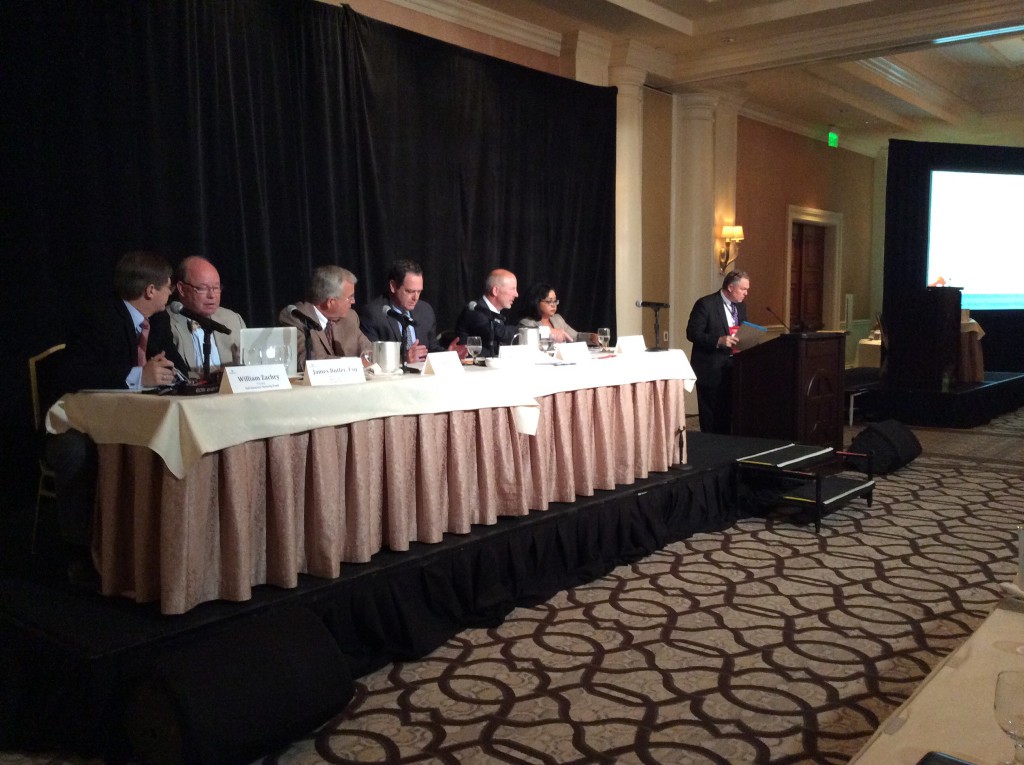The Current State of California Workers’ Compensation & Looking Forward
The California Workers’ Compensation & Risk Conference in Dana Point opened with a session featuring employers and stakeholders in the industry weighing in on the current state of California Workers’ Compensation and what’s on the horizon for 2015.
Panelists were moderator Mark Walls, VP Communications & Strategic Analysis at Safety National, William Zachry, VP of Risk Management at Safeway, Tim East, Director of Risk Management at The Walt Disney Company, Bill Mudge, President & CEO at WCIRB California, Kurt Leisure, VP of Risk Services/Asset Protection at the Cheesecake Factory, Seeta Ambati , Esq., (defense attorney) Partner at Laughlin, Falbo, Levy & Moresi, LLP, and James Butler, Esq., (plaintiff attorney) Attorney at Law at Butler Viadro LLP.
The panel began with a look at where California Workers’ Compensation is today.
• California holds a quarter of the nation’s workers’ compensation business.
• To date, 80 new carriers have entered the California market since 2004.
• California is among the top three states in terms of average medical costs per claim.
• California has experienced double digit increase in premiums over the last two years.
Cost drivers to the California Workers’ Compensation system include:
• A high frequency of claims handling in the state relative to payroll, with Los Angeles County having the most claims in the region.
• A multitude of expensive permanent disability claims that include attorney involvement.
• The frequency of opioid prescriptions has doubled.
SB 863 is California’s answer to addressing these costs, however, it is too early to provide tangible data that supports if the reform has been successful. Some early data shows that costs related to liens are down but independent medical reviews are up.
Panelists were split as to whether the SB 863 reforms have been successful. Some say that, although too soon to judge, they are seeing the following positive indications that it is working:
• Generally, rate increases have been cut in half due to costs taking a downward trend.
• The highest costs are coming from old medical claims, rather than recent claims.
• Because this is the first time that California has seen cost decline in quite some time, panelists thought that the cost cuts may make the state appear more employer friendly and it will encourage companies to return.
Panelists noted that there are still some kinks to work out in the reform. One stated that the Independent Medical Review (IMR) process, which has been redesigned to take non-medical professionals out of the medical decision process, is working well. On the other hand, the opioid decision process in place is currently not solving the costly opioid problem. Overall, people are still learning the new process, but they think that outcomes will be positive over time. They think that the measures are in place to help get the injured worker healthy and back to work. From a big perspective, they note that peer-to-peer review is the right approach and the system is better than it was.
The CAAA strongly disagrees, however, and views the reform as a failure that is harming citizens. A representative said that they saw more employees returning to work prior to the reform and the system is averaging 4.3 denials per patient. They cite the cost of administering workers’ comp as one of the largest costs a business can endure. In addition, they believe that peer-to-peer review is not working efficiently. The CAAA thinks that legislative efforts to reform workers’ compensation is aiming at the worst-case scenarios, rather than the majority and, therefore, has not provided the best solutions for most companies.
Each panelist was asked what changes they would make to the California Workers’ Compensation system if he or she was Governor for the day. Suggestions included:
• Taking a fresh look at this 101-year old system overloaded with rules, legislation, audits and controls. It’s time to simplify a system that currently has layers of new rules on top of old rules and, as a result, enormous costs related to it all.
• Do away with cumulative trauma, which is a major cost driver that creates complexity. Some states have already done this.
• Make use of alternative dispute resolution. California has gone from incentives and positive reinforsement for providing prompt payments and benefits to a system of gotchas. It needs a system that rewards promptness and minimizes disabilty.
• Address the opioid abuse and cure system to make every effort to avoid addiction.
• California needs to look at the system from eye of the injured worker and symplify accordingly. Employees can’t understand the current complex system, that’s why they seek legal representation.


